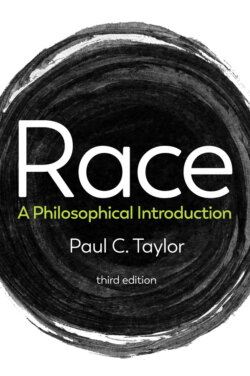Race

Реклама. ООО «ЛитРес», ИНН: 7719571260.
Оглавление
Paul C. Taylor. Race
CONTENTS
List of Tables
Guide
Pages
Race. A Philosophical Introduction
Preface to the Third Edition
Notes
Acknowledgments
Introduction
Note
1 The Language of Race. Prologue – Black Power mixup
1.1 Race-talk and the invitation to philosophy
1.2 Setting the context
1.3 Taking race seriously
1.4 Words vs things
1.5 What do you mean, “we”?
1.6 What race-talk does
1.6.1 Bodies (appearance)
1.6.2 Bloodlines (ancestry)
1.6.3 Assigning generic meaning
1.7 Modern racialism
1.8 Politics and method
1.8.1 Politics and context
1.8.2 Systems and structures
1.8.3 Process and power
1.9 Conclusion
Notes
2 Unnatural Histories. Prologue – When were Mona’s dumplings?
2.1 Introduction
2.2 The pre-modern background
2.3 Early modern racialism
2.4 High modern interpretations of race
2.5 High modern racial structures
2.5.1 The racial state
2.5.2 Consolidating whiteness
2.6 Classical racialism vs critical racialism
2.7 Late-modern racialism
2.7.1 On the meaning of civil rights
2.7.2 Transition: The Moynihan Report
2.8 Post-modern racialism
2.9 Conclusion
Notes
3 Three Challenges to Race-Thinking. Prologue – Not black black; or, the Wobbly, the Rasta, and the Ex-White man
3.1 Introduction
3.2 Isn’t race-thinking unethical?
3.3 What racism is
3.4 Isn’t racial biology false?
3.4.1 The first problem – splitting and discreteness
3.4.2 The second problem – lumping and clusters
3.4.3 The third problem – against inheritance
3.5 Isn’t the race concept just in the way?
3.5.1 Ethnicity
3.5.2 Nation
3.5.3 Class
3.5.4 Caste
3.5.5 Sex/gender
3.6 Mergers and injunctions
3.7 Conclusion
Notes
4 What Races Are: Twenty Questions. Prologue – race is, race ain’t
4.1 Introduction
4.2 Subjects and objects, concepts and conceptions
4.3 Patterns and proposals, Cornish and criticism
4.4 Language and reality, irony and asterisks
4.5 Cost and benefit, culture and nature
4.6 Conclusion
Notes
5 Facing Race: Existence and Experience. Prologue – Pure; or, the fourth life of Mona Rogers
5.1 Introduction: Arriving, using, facing
5.2 Ethical eliminativism (the anti-racist challenge, continued)
5.2.1 The slippery slope and the argument from political realism
5.2.2 The argument from self-realization
5.3 Existence, identity, and despair
5.3.1 The basics
5.3.2 Despair and doubt, joy and pain
5.3.3 Double consciousness
5.3.4 Micro-diversity
5.4 Beyond the black–white binary
5.4.1 Latinx peoples, outsider racialization, and the gendered substratum
5.4.2 Asian peoples and model minority racialization
5.4.3 Native Americans and savagism
5.4.4 Arabs, Muslims, and the terrorist panic
5.5 Experience, invisibility, and embodiment
5.5.1 The basics
5.5.2 Invisibility and the other mind–body problem
5.5.3 From the ontic to the ontological
5.6 Conclusion
Notes
6 The Color Question. Prologue – Keanu and the promotion; or, good job, good teeth
6.1 Introduction
6.2 The ethics of endogamy
6.3 Choices in context
6.4 Weighing some arguments for endogamy
6.5 Self-criticism and social criticism
6.6 Culture, privacy, and policy
6.7 Color and culture4
6.8 Affirmative action: background and arguments
6.9 Affirmative action: suspect classifications
6.10 Conclusion
Notes
7 A Funny Thing Happened on the Way to Post-Racialism. Prologue – What’s what we’ll see; or, nine-inch knives and six-inch stimuli
7.1 La Règle du jeu (The rules of the game)1
7.2 On post-racialism2
7.3 What the Obamas meant
7.4 The nexus of immigration and race
7.5 Immigration enforcement as a racial problem
7.6 Immigration politics as a racial project
7.7 Globalization
7.8 Securitization
7.9 Conclusion: Post-post-racialism and the first white president
Notes
Further Reading
Index. A
B
C
D
E
F
G
H
I
J
K
L
M
N
O
P
Q
R
S
T
U
V
W
X
Y
Z
POLITY END USER LICENSE AGREEMENT
Отрывок из книги
Third Edition
Paul C. Taylor
.....
If I’m right, focusing on the Anglo-American model of race-thinking doesn’t have to get in the way of telling a more global story about race. Unfortunately, the narrower focus may have its own internal difficulties. I’ve already said that we use race-talk in unclear and inconsistent ways, so how do I propose to reduce that semantic diversity to a single model?
Using the same words in unclear and inconsistent ways is not a problem that’s unique to race-talk. The elements of language are tools, and like any other tools, they can play roles beyond the ones for which they were originally created. Just as some people use irons not just to remove wrinkles from their clothes but also to make grilled cheese sandwiches, sometimes people repurpose words in ways that give them strikingly new meanings. Think of the way names like “Karen” and “Becky” have come to stand in for objectionable personality types. (In current vernacular usage, “Karen” refers to “women, usually white, who commit acts that are perceived to be bullying and sometimes racist,” as in the “Central Park Karen” incident from May 2020.)5
.....